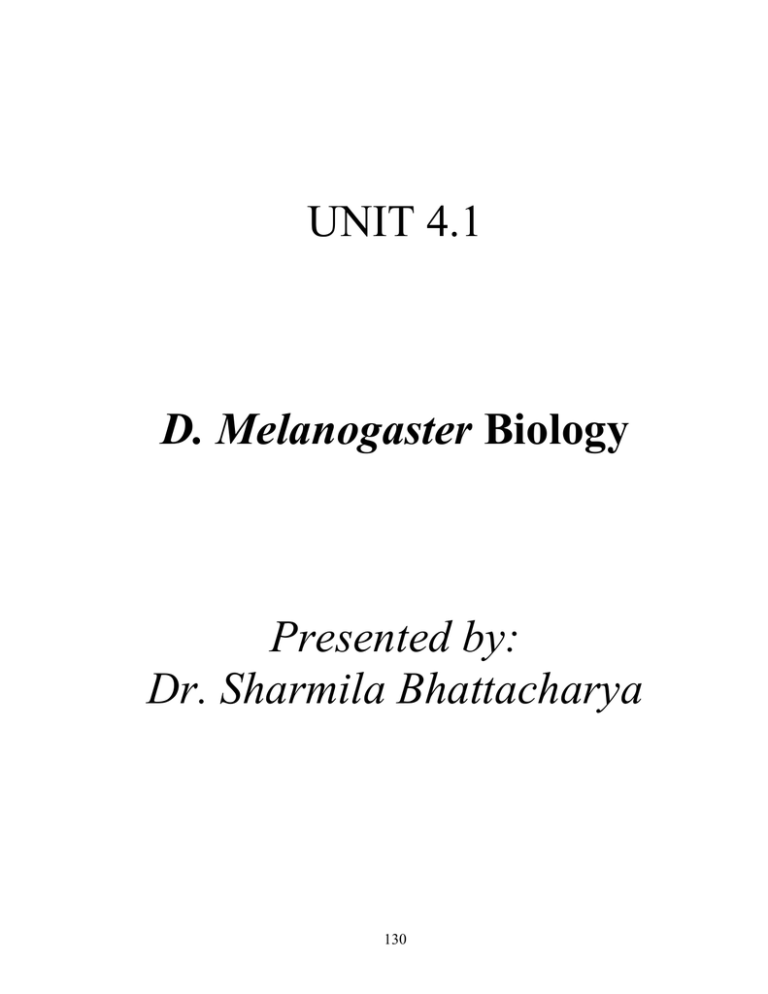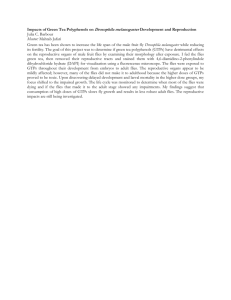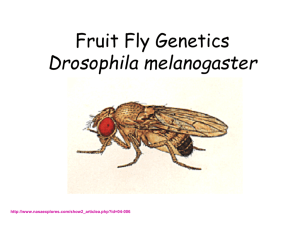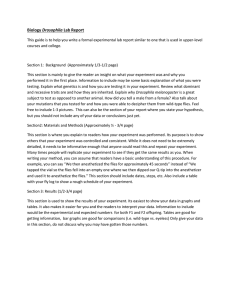UNIT 4.1 D. Melanogaster Presented by:
advertisement

UNIT 4.1 D. Melanogaster Biology Presented by: Dr. Sharmila Bhattacharya 130 NEMATODES AND INSECTS UNIT 4.1 D. melanogaster Biology Dr. Sharmila Bhattacharya Vocabulary: • • • • • • • • Gene Genotype Gravitaxis Heterozygous Homozygous Invertebrate Phenotype Species Purpose: Drosophila melanogaster, is the classic organism for the study of animal genetics. It was introduced to the lab early in the 20th century by Thomas Hunt Morgan. Mutant flies, with defects in any of several thousand genes, are now used for the study of genetics, development, behavior, and other topics. Objectives: a) Describe the basic characteristics of Drosophila Melanogaster “D. melanogaster.” b) Describe the basic life cycle of D. melanogaster. c) Explain why D. melanogaster is critical to basic research. d) Describe the Gravitaxic Maze and its use in research. e) Describe gravity response behavior of D. melanogaster. f) Recall results from past D. melanogaster flights. 131 NEMATODES AND INSECTS Basic Characteristics Size: Adults 3mm; Eggs 0.5mm Diet: Rotten fruit Life cycle: 2-8 weeks ‘Omics Genome size: 180 Mb Chromosomes: 3 autosomes, plus X and Y Number of genes: ~13,639 predicted Average gene: 3 kb, 4 exons per gene Proteins: 77% have a match with other organisms Stats Reproduction: Females can lay up to 100 eggs in one day Development: 10 days from fertilization to adult The Scientist, June 2, 2003 132 NEMATODES AND INSECTS 133 NEMATODES AND INSECTS Why are flies critical to basic research -- especially gravity research? • Breeding generations is convenient and fast (multigenerational studies, and statistically significant numbers in small volumes). • Intrinsic gravity responsive behavior (negatively gravitaxic). • Sophisticated genetic tools and markers readily available. • Multitude of genetic mutants characterized -- help identify genes involved in process of interest; e.g., gravity perception and response. • Genome has been completely sequenced. • Several fundamental processes conserved with higher organisms such as humans and rodents; e.g., nervous system function. • Well-studied developmental stages of growth -- can look at perturbations in muscle, nerves, etc. after altered gravity exposure. 134 NEMATODES AND INSECTS NEGATIVE GRAVITAXIS Gravitaxic Maze • Populations of 25 flies used per run • Flies attracted to traverse the maze with light • Eight up/down choice points so that flies exit at nine possible positions (Armstrong & Beckingham) Close-Up of Vertical Choice Point Tubing is only wide enough for flies to walk the maze, not to fly. Several Mazes In Operation Collection tubes at the nine exits have “one-way” entry devices. 135 NEMATODES AND INSECTS 9 7 The mazes measure a response to gravity 5 vertical 3 1 0 10 20 30 25 20 15 horizontal 10 5 0 1 2 3 4 5 6 7 8 9 9 7 5 Mutant Lines that show high and low behavior have been isolated CG12758 3 1 0 20 9 7 5 otk 3 1 0 10 20 30 136 40 40 60 80 NEMATODES AND INSECTS Mutants, Balancers and Markers X __gm X*___ SM5, Cyo gm X* gm X* gm X * SM5, Cyo 1/4 fully mutant straight wings [Homozygous mutant] gm X*_ SM5, Cyo 1/2 curly wings like parent generation [heterozygous] __gm X*___ SM5, Cyo SM5, Cyo SM5, Cyo 1/4 lethal Gravitaxic Mutation X = gm X* SM5, Cyo= Balancer chromosome marked with curly HOW DOES A HOMOZYGOUS GRAVITAXIC MUTANT BEHAVE IN SPACE COMPARED TO THE HETEROZYGOUS SIBLING? Eye Color Gene as a Marker on Balancer Chromosomes 137 NEMATODES AND INSECTS Behavior • • • • Has the advantage of being a multi-cellular organism. Flies sleep, move, mate, show food and odor preferences, etc. Flies can learn. Flies learn less well when sleep deprived. (Does this sound familiar?) Gravity related changes in behavior • Our data shows that in hypergravity there is a change in behavior. • Little past data from behavior in space, but consistent with increased movement in microgravity; gravity-effect seems to be a continuum. Drosophila as a molecular biology tool • Genome has been sequenced (microarrays available to probe all genes turned on and off in response to changing environment). • Mutant lines are readily available. • Molecular determinants (genes) responsible for essential biological processes conserved between flies and mammals: o Disease paradigms: Parkinson’s, Huntington’s diseases, etc. o Nervous system function o Circadian (day/night sleep) rhythms o Learning and memory, etc. 138 NEMATODES AND INSECTS Past Studies From Space Flight • Effects of radiation: mutagenesis and effects on chromosomes • How gravity affects: o Development: It is known that muscle activity can affect nervous system development. A detailed analysis of the development of these systems in space will be important and preliminary results appear interesting. o Movement and behavior: There is some scanty evidence from the past that these are affected. Video images, large sample sizes, multiple generations will help confirm results. o Growth and reproduction: No gross morphological changes, but there are alterations at the tissue level. o Aging: Studies in the past show some indication that space flights affect aging in fruit flies - Needs further experimentation. In Summary So Far • Flies show measurable behavior changes in response to gravity (negative gravitaxy). • Flies have useful mutants related to gravity and behavior that we can study (genetic system). • Flies are a powerful molecular biological tool (sequenced genome, tools to manipulate genome/transgenic flies, microarrays to probe gene expression, etc.). They are a Multi-cellular organism with many vital processes similar to mammals and therefore of relevance to multiple species. 139 NEMATODES AND INSECTS Conclusions • Drosophila melanogaster is a powerful research tool. • There is still much that we need to know about the effects of gravity on living organisms. • Flies occupy little space, air, and their food consumption is low; large populations can be maintained; multiple generations can be studied; and there is conservation of essential processes with other animals including mammals. Reference Materials The following online resources are available for more information about Drosophila Melanogaster: Drosophila Virtual Library: http://www.ceolas.org/fly/index.html Flybase: http://www.flybase.bio.indiana.edu Drosophila DNA Microarray Homepage: http://www.cmgm.stanford.edu/~kpwhite/index.html 140 NEMATODES AND INSECTS Notes: 141








